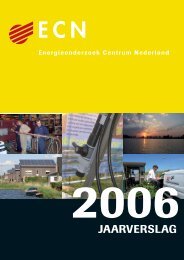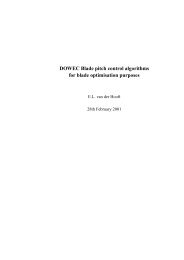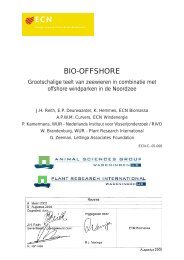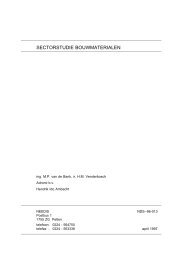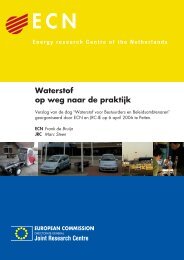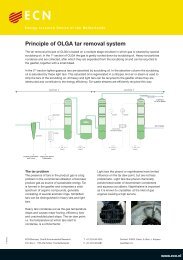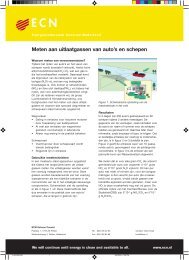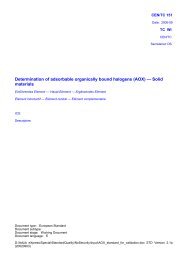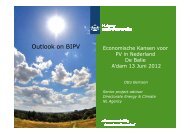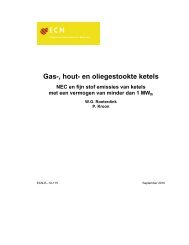PDF format (503 kB) - ECN
PDF format (503 kB) - ECN
PDF format (503 kB) - ECN
You also want an ePaper? Increase the reach of your titles
YUMPU automatically turns print PDFs into web optimized ePapers that Google loves.
To model the category boxes we will define two basic types of boxes: the cardboard box and the plastic box. We<br />
will also model a cardboard box with an inner bag. The standard cardboard box has a volume of 1 liter and<br />
weighs 35 grams. The inner bag will add another 3.0 grams (PE) or 7 grams (paper). A market share of 20% of<br />
the cardboard box market is assumed for the box with the inner bag. The plastic box will contain some cardboard<br />
in order to simulate the share of blister packaging. We will define a plastic box with a volume of 0.5 liter<br />
that contains 10 grams of plastics (HDPE) and 2 grams of cardboard.<br />
Three improvement options are defined. The first deals with the use of smaller boxes, removal of trays, increasing<br />
product quantity, refill packages and use of thinner material. This is modeled by lighter boxes (28<br />
grams). The second option replaces the inner bag by sealing of the box. The third improvement replaces the<br />
plastic blister with a cardboard blister (17.5 grams) as done intensively in the DIY sector [SVM 1992-1996].<br />
2.4 Flexible packaging<br />
From a materials point of view this group of packaging materials basically consists of three subgroups: plastic<br />
films, paper wrappings and aluminum films. Plastic films can be further broken down into different types of<br />
monolayer films and laminates. The total European market for flexible packaging amounts to some 5.2 million<br />
tonnes, of which PE films are estimated at 4.2 million tonnes and PP film at 0.8 million tonnes [APME, 1996].<br />
Possible material changes in flexible packaging depends heavily on the products that are packed. For many<br />
food products barrier properties for moisture and gasses, especially oxygen and carbon dioxide, play a crucial<br />
role. Other products do not need high barrier properties. For this reason we modeled high and low barrier films.<br />
In case of low barrier food films we modeled 1 liter bags out of LDPE (3.7 gram) and PP (2.7 gram). Substitution<br />
between the films can already improve material efficiency but specific improvement options are metallocene<br />
films which are about 20% thinner (2.2 grams) due to improved polymerization control in the production<br />
process [Anon. 1995, 1996, v. Stijn, 1996, 1997] and the use of paper wrappings (8 grams). In case of high barrier<br />
films several laminates are modeled which consist of two or more layers of different materials. Laminates<br />
either consist of two or more different plastics, or of a plastic with another material (e.g. aluminum or paper).<br />
We modeled PP, PET and metallocene laminated with PVdC (a super thin coating with excellent barrier properties)<br />
and the same plastics with a coating of aluminum.<br />
Flexible packaging can also be used to pack non-food packaging and industrial packages. For non-food packaging<br />
we used the same films as for low barrier food packaging. For industrial packaging typical films are<br />
stretch films and shrink covers. These are used to bundle several packages together and often fix these bundles<br />
to pallets. Shrink covers are assumed to be 140 m thick and a reduction to 100 m is assumed to be possible<br />
[Zoethout, 1997]. Stretch films are assumed to be 30 m thick but multiple turns around a pallet are necessary.<br />
Shrink films can in some cases also replace corrugated boxes. For shrink films we used an average thickness of<br />
50 m and a possible reduction in thickness of 10% [SVM, 1994, Plasthill, 1997, Zoethout, 1997].<br />
2.5 Carrier bags<br />
Carrier bags are most often made out of plastics, more specifically PE. Both LDPE and HDPE are used for the<br />
production. HDPE bags are normally lighter than LDPE bags [SVM, 1992]. Many different kinds of carrier<br />
bags are used in Europe which depends on the specific function of the bag. The thickness varies between 10 to<br />
200 m [Donker, 1993].<br />
Several initiatives have been taking place in order to reduce the amount of plastics used for plastic bags. Many<br />
projects focussed on prevention. In the Netherlands this resulted in agreements in 1991 between the government<br />
and stores that plastic bags will not be handed out for free [CV, 1992]. These measures resulted in a reduction<br />
of the amount of carrier bags because consumers started to reuse bags or make use of durable carrier<br />
bags. Other initiatives focussed on alternative materials for carrier bags like paper.



